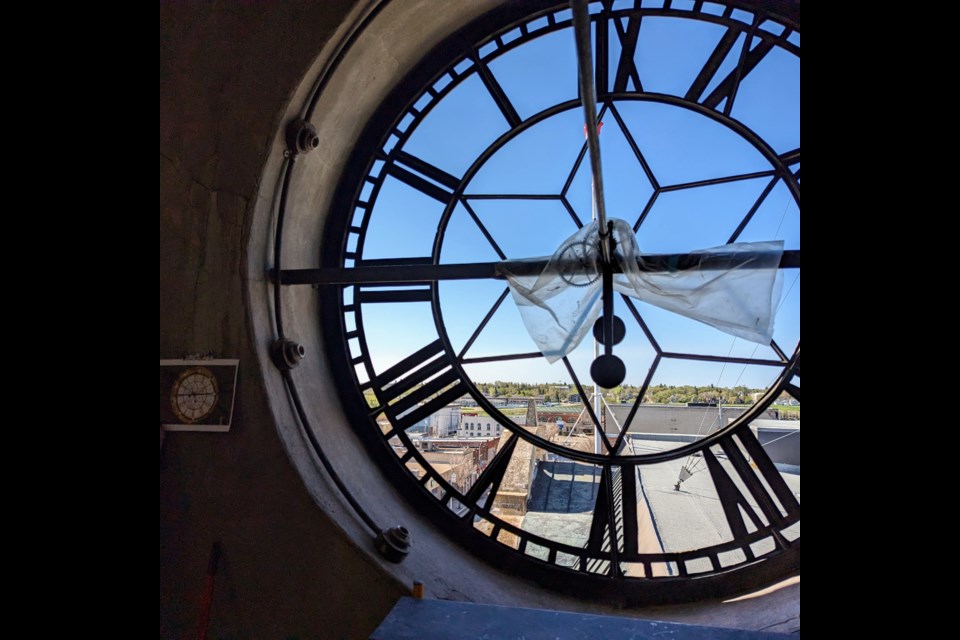City Hall is one of Moose Jaw’s most historic and significant pieces of architecture, and the clock tower at its top is its crowning glory, which is why some true-to-heritage facelifts have been ordered and will be completed by the end of summer.
“The clock’s 107 years old, so over time there’s been a lot of wear and tear,” said Cory Oakes, the operations manager for the parks and recreation department. “Because it is a heritage building, it is a heritage mechanism … there is not really any room to modernize. We’re going with that same stainless glass, opalescent, same kind of marbling, everything that goes along with that.”
There are 97 separate pieces of glass making up the clock faces. Over the years, as those pieces have become damaged or broken, they’ve been replaced one by one with pieces of plexiglass — dull, not very resilient, and difficult to shine lights through for events like Christmas, when the tower goes red and green.
City council and the heritage advisory committee have approved a budget of $55,400 for the repair, which will also include the refurbishment of the clock’s hands, a pressure wash for the stone façade, and a transparent, shatter-proof ballistic coating to protect the restored glass of the faces from extreme weather and bird impacts.
“This is part of the history of Moose Jaw,” Oakes said. “We want to make sure we preserve it for future generations.”
“This is why we have the heritage committee, right?” said Craig Hemingway, the city’s communications manager. “We know how important it is to our residents to preserve our history. It’s a big priority for our residents, they want to see our history and heritage cared for, where possible, and this is a prime example of being able to accommodate that.”
The clock is believed to have been originally installed by Wilson and Maybee, Moose Javian watchmakers and jewellers. However, it was manufactured in England by Smith and Sons, now named Smith of Derby — a company that has made clocks for churches and public buildings all over the world since 1856.
A ledger entry dated Oct. 24, 1913, shows the clock was shipped overseas on the SS Tunisian from Liverpool to Montreal, then transported by CP Rail to Moose Jaw. The 800-lb, art-inscribed bronze bell that sits above the clock arrived on the same shipment.
The clock needs to be hand-wound every 14 days, which is done by a heritage committee-approved expert/enthusiast. The clock mechanism was restored in 2014 and remains in excellent condition.
The bell was supplied by John Taylor & Co. of Loughborough, Great Britain to Smith and Sons as part of the clock order. Despite the bell’s reported beauty and clarity, it hasn’t rung in decades. It hangs from the original timbers, and the only work in recent years has been for safety purposes.
Repairing the bell before the clock tower glass might have shattered the remaining original panes on the first ring. With the glass completed, the heritage committee can take a serious look at re-ringing the bell for special occasions, or at least making it easier to see and admire.
The building that is now city hall was constructed between 1911 and 1914, designed by Chief Dominion Architect David Ewart. Ewart was responsible for many federal buildings constructed during that period, including the Connaught Building in Ottawa, various structures on the grounds of the Royal Military College of Canada, dozens of historic armouries across the country, and the Prince Edward Building in Regina.
Moose Jaw’s city hall was originally a post office, sister to the Ewart-designed Post Office Building at the Sinclair Centre in Vancouver, which also has a Smith and Sons clock.
The building saw various other uses over the past century, including by the RCMP at one point. In 1963, the City of Moose Jaw purchased it to use as City Hall.




